Three major hurricanes made landfall in the U.S. and Puerto Rico during August and September, causing catastrophic damage and hundreds of deaths. The first was Harvey, which heavily damaged Texas at the end of August.
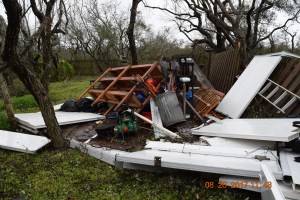 The remnants of a shed litter the backyard at the home of Kara Thompson’s parents in Rockport, Texas, after Hurricane Harvey.
The remnants of a shed litter the backyard at the home of Kara Thompson’s parents in Rockport, Texas, after Hurricane Harvey.
As Harvey made landfall about 10 p.m. Aug. 25 near Rockport, Texas, with sustained wind speeds of 130 mph, Kara Thompson, a biologist at Hanson’s Corpus Christi, Texas, office, watched via television coverage and social media. “It’s one thing to see the force of nature destroying everything in its path in a foreign area; it’s an entirely different thing to see it destroying your hometown,” she recalled.
Kara rarely moved from the living room couch while she watched The Weather Channel, with a laptop next to her so she could continuously check for social media updates from independent and Austin news station storm chasers in Rockport. She and her boyfriend, Patrick, were safe at the home of their friend’s aunt in Boerne, about 160 miles away.
“The live-streaming videos while the eyewall was passing over Rockport-Fulton were absolutely terrifying,” she said.
“It’s one thing to see the force of nature destroying everything in its path in a foreign area; it’s an entirely different thing to see it destroying your hometown.”
─ Kara Thompson
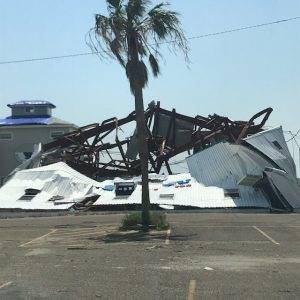 Harvey destroyed the Aquarium at Rockport Harbor. Kara said the nonprofit plans to rebuild. Photo provided by Mike Probst
Harvey destroyed the Aquarium at Rockport Harbor. Kara said the nonprofit plans to rebuild. Photo provided by Mike Probst
A little more than 48 hours before, Kara was not expecting Harvey to approach with such force. She closely monitored the weather forecasts and gathered nonperishable food, water and ice in case the storm caused the power to go out in Corpus Christi, where Kara and Patrick live and work. Kara helped secure Hanson’s Corpus Christi office for the storm while Patrick secured job sites and equipment for the company he works for.
As the forecast for Harvey intensified, so did the efforts to prepare homes and businesses — and to evacuate. “Growing up on the coast, we knew it was only a matter of time before we were hit by a hurricane,” Kara said, but when she learned that Harvey was predicted to hit Corpus Christi as a Category 3 storm, she became scared. “I was experiencing my first major hurricane as an adult … . I had family, friends, my dog, a home, personal possessions and a vehicle that I was responsible for. Nobody was going to tell me what to do or when to do it; I had to make that call, and there wasn’t any time to waste.”
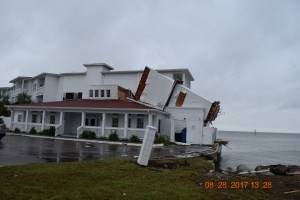 The Lighthouse Inn at Aransas Bay is being repaired, but it will not reopen before the end of the year.
The Lighthouse Inn at Aransas Bay is being repaired, but it will not reopen before the end of the year.
She drove about 40 minutes to Rockport to help her parents pack up personal items and valuables. Her parents boarded up their home and veterinary clinic and would travel to San Antonio the next day. Kara returned to her home and moved outdoor items, such as furniture and gas grills, into the garage and boarded up windows. While doing this, the hurricane was forecast to directly hit the Rockport area. “My heart sunk, but I didn’t have time to really fathom that occurring, because there was so much left to be done.” Patrick returned from boarding up his parents’ and grandparents’ homes and his mother’s retail store in Corpus Christi. They gathered their belongings and dog, finished boarding up their home, then helped their friend board up her house before following her to Boerne. It took about six hours to make the trip; they arrived at 2 a.m., 20 hours before landfall.
 Kara and her boyfriend, Patrick, helped gut sheetrock and remove personal belongings from their friends’ Copano Height home. This photo shows some of the furniture and sheetrock that was removed to be thrown away.
Kara and her boyfriend, Patrick, helped gut sheetrock and remove personal belongings from their friends’ Copano Height home. This photo shows some of the furniture and sheetrock that was removed to be thrown away.
Harvey’s Category 4 winds leveled structures and brought sweeping destruction to the Aransas County coastal city. “Rockport was devastated,” Kara said. “There was no power, no utilities, no cellphone service, downed power poles and lines everywhere, debris and destruction everywhere. The conditions were very dangerous.”
Her parents’ clinic sustained moderate damage, mostly to the fence and awnings. It had some standing water and a few roof leaks. Their home’s fence, shed and porch awning were lost, and the roof and chimney were damaged, but there were no internal issues. They stayed with Kara and Patrick in Corpus Christi for two weeks after the storm, until electricity was restored in Rockport.
After making landfall at Rockport, the tropical cyclone brought widespread flooding to the Houston metropolitan area, dumping at least 30 inches of rain in many locations there. Kara said that media coverage on Rockport quickly waned and focused on Houston, and it seemed that people forgot the devastation in Rockport. “The destruction is just unreal, even in a day and age where we see destruction on the news every day,” she said.
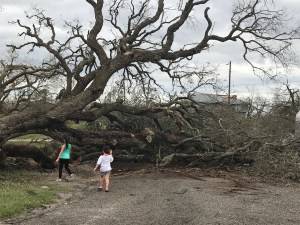 Copano Heights was extremely hard-hit. This tree fell at the residence of Kara’s close friends in that neighborhood. Photo provided by Bonnie Richleny.
Copano Heights was extremely hard-hit. This tree fell at the residence of Kara’s close friends in that neighborhood. Photo provided by Bonnie Richleny.
In the aftermath, Kara and Patrick dedicated what time they could to helping her parents, friends and family friends clean up debris. They also spent about 10 hours helping close friends remove all personal belongings from their Copano Heights home, then rip out the bottom 4 feet of sheetrock from the walls.
Kara knew that donations were immediately needed in Rockport. “I offered to receive donations in Corpus and transport them to Rockport, or any other areas. My main focus was fulfilling the needs for the first responders and collecting items needed for cleanup,” she said. “I received about half a dozen inquiries from complete strangers, one as far as New Jersey.” She collected close to $1,500 in donations and cash, which she delivered to churches, the animal shelter and volunteer fire departments.
Meanwhile, Hanson donated $15,000 to a relief fund that Joe McComb, Corpus Christi’s mayor, established through the Coastal Bend Community Foundation, and challenged its employees to match or exceed that contribution. The match challenge drew an additional $12,635 by the end of September for the Mayor’s Hurricane Harvey Recovery Fund, which is focused on providing relief to coastal communities in five counties, especially their infrastructure and revitalization efforts.
“The progress the community has made is astounding,” Kara said. “But there are still people living in tents, and it’s estimated that 6,000 people lost their homes … . Rockport won’t be back to ‘normal’ for three to five years, and I don’t think it will ever be the same.”
Hurricane Irma hits Florida
In early September, Elise Legg, an administrative assistant and proposal coordinator for Hanson’s Orlando, Florida, regional office, was preparing for Hurricane Irma with her husband, Laird. Florida’s governor declared a state of emergency Sept. 4 in anticipation of Irma, which had reached Category 4 strength that day and was on a path toward Cuba and the Florida Keys before entering mainland Florida from the south. It was the first major hurricane to hit Florida since 2005’s Hurricane Wilma.
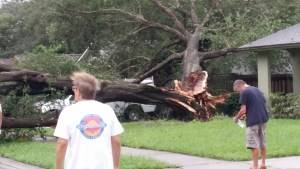
“I was concerned that our neighbor’s oak trees would fall on our house,” Elise said. The trees, which hang over Elise and Laird’s backyard, were trimmed in August to prepare for the hurricane season, but posed a threat if they became uprooted during the storm.
The couple lives in a small subdivision in Longwood, which is northeast of Orlando. When they heard about Irma’s approach, they prepared by boarding up their windows and making sure they had the supplies they needed.
After the Sept. 11 storm, Elise and Laird discovered minimal damage in their backyard. And luckily, they had not lost power. “We were very fortunate that we did not lose power during or after the storm,” she said.
However, their neighbors on the south side of their street were without electricity for nine days. One couple is elderly; the wife, who has cancer, is on oxygen. The Leggs ran extension cords across the street so that she could use the oxygen. Another neighbor provided a generator to power the couple’s window air conditioner and refrigerator. Laird and his next-door neighbor made sure the generator had gas and started it up when it would shut off.
The couple also opened their home to another family that lost power. The family chose to sleep in their own home, but used the Leggs’ refrigerator to store food. They would visit a couple of times each day to make coffee, get something to eat, charge their cellphones and check their emails on the computer.
Irma caused destruction in the Florida Keys while wind damage, flooding and power outages occurred across Florida. In the Orlando area, the hurricane cut power to thousands, took down trees and caused property damage, but overall, the damage was minimal.
“The devastation caused by Maria in Puerto Rico makes the effects of Irma in our area seem minuscule,” Elise said. “My heart really goes out to them.”
Employees donate to help Hurricane Maria victims
Hurricane Maria was on Mattie Valente-Freitas’ mind, too. Maria was a Category 5 storm when it made landfall in the Caribbean on Dominica, becoming the worst natural disaster recorded there, destroying most of the vegetation, buildings and infrastructure. It created a humanitarian crisis in Puerto Rico after it landed Sept. 20, leaving widespread flooding and devastating destruction behind.
When Mattie heard that a friend, who is from Puerto Rico and has family there, was collecting donations to send to that island, she called on her co-workers at Hanson’s New York metropolitan office to help. Mattie, a senior administrative assistant, and Yolanda Laboy, a marketing assistant, donated several items themselves.
 Mattie Valente-Freitas dropped off a variety of items collected from her Hanson co-workers and others for her friend’s donation drive to help Hurricane Maria victims in Puerto Rico.
Mattie Valente-Freitas dropped off a variety of items collected from her Hanson co-workers and others for her friend’s donation drive to help Hurricane Maria victims in Puerto Rico.
“Yolanda actually went out and purchased several lanterns, lots of batteries, aspirin, feminine hygiene products, et cetera,” Mattie said. Mattie added first-aid supplies, baby items and lots of children’s clothing and shoes. She also collected items from family members, friends and Girl Scouts in the troop she leads.
Through a contact at JP Morgan, the donations were collected at drop-off sites in the area until Oct. 6 before being transported to Puerto Rico via American Airlines.
“We are hoping that all the stuff that was donated gets distributed quickly,” Mattie said. “It’s hard to watch the news and know that a month later, there are still people without any power or fresh water.”
For Kara, “the most crushing feeling was realizing how many people lost everything and trying to imagine what it would be like having to rebuild their lives from the ground up.” She said when natural disasters like Harvey strike, the most direct way to help is to donate to a reputable local charity or organization. “Churches, volunteer fire departments, humane societies, resale shops, schools, day cares,” she said.
“If you’re able to connect with or donate to someone from the community or someone who is making a trip to the area, ask them what is needed and have them deliver it. Or, call a church and ask if there’s a family you can ‘adopt.’ ”